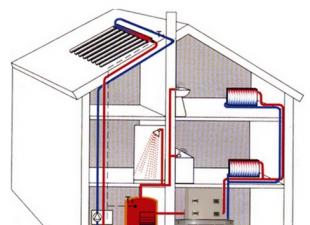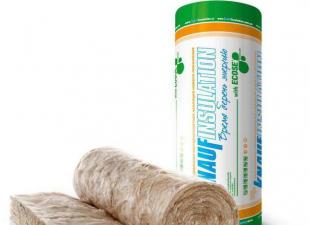The cold season traditionally brings low temperatures and the desire to turn on the heating to the maximum. But heating costs will rise to really large sums. There is a way out - to insulate the room with foil material. What are these heaters?
The advantages of insulating material with foil
Foil insulation has many advantages that are often lacking in other materials. It is these "advantages" that distinguish insulation with foil against the background of a wide variety of insulation products:
- Increased ability to reflect heat. Foil is a wonderful reflector that can repel about 95% of heat radiation, keeping heat in the house and not letting heat into the room. By the way, it is for this reason that protective suits for firefighters are made from a foil heat insulator.
- Waterproofing. Foil is a hydrophobic material that repels moisture.
- Ease of use. Foil insulation has a honeycomb structure, which not only insulates well, but is also easy to install.
- Isolation from external influences. Foil heaters do not let wind, dampness through, do not freeze in winter and do not dry out in the hot season.
- Noise absorption - the use of insulation with foil allows you to achieve silence in the room and significantly reduce the amount of noise coming from outside.
- Safety for health and environmental friendliness. The foil has no harmful effects on the human body, does not emit potentially hazardous substances and does not harm the environment.
- Durability. Reflecting all external influences, the foil can serve for a long time without any manifestations of rust, rot or corrosion.
- Elasticity. The foil material can be easily molded into any desired shape.
introductory video
Technical characteristics and cost of materials with foil
The technical characteristics of all existing foil insulation cannot be called at once - different materials have different properties. However, you can give the characteristics of several of the most popular heaters.
Universal insulator made of polyethylene foam

The material is usually supplied in rolls. Its thickness can vary from 2 mm to 1 cm. Polyethylene foam can be covered with foil on one side or both. In addition, self-adhesive versions of such a heater are produced, when an adhesive layer is applied to the material on one side, covered with a protective film. The thermal conductivity of polyethylene is 0.038 W / (mK), the specific gravity of the material with a thickness of 0.5 cm is 60 kg / meter. Moisture absorption by different types of this material can range from 0.6% to 3%. The use of polyethylene insulation with foil is usually not limited by any framework: the material can be used to insulate the walls and floor in the room, the ventilation system, the roof of the building, insulate pipes or refrigerators. Often foamed polyethylene with foil is used for equipping a warm floor under a screed, as a finishing base for a laminate or linoleum, for thermal insulation of saunas.
To prevent heat from escaping through the walls, a layer of polyethylene insulation is fixed behind the battery so that between it and the insulation there is a free space of at least 2 cm.
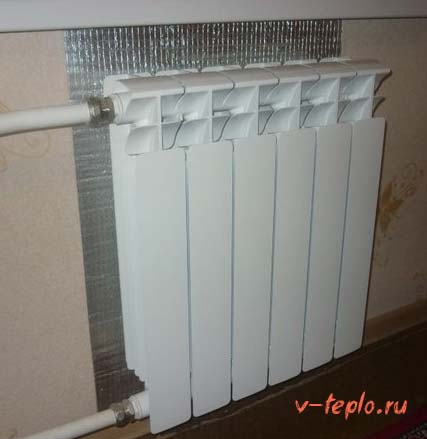
Foiled polyethylene has also found original use in the shoe industry - shoe insoles are made from it.
In domestic stores, you can most often find such brands of foil polyethylene: Izolon, Ecofol, Penofol. The cost of one roll (50 square meters on average) of such an insulator will depend on its thickness. For example, a roll of 2 mm insulation will cost the buyer 1680 rubles, a roll of material, the thickness of which is 1 cm, will cost 3400 rubles. Foil polyethylene Germaflex has such a cost, but there are also less expensive materials on the market, a roll of which will cost 900 rubles.
Foil mineral wool
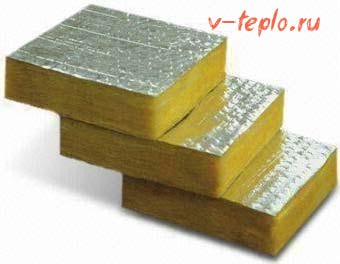
In this insulation, the foil is usually deposited on only one side of the material. It is produced in two formats: plates or rolls with an insulator layer thickness of 5 to 10 cm. It can be made of fiberglass or stone basalt wool.
The use of insulation with this type of foil is limited: since cotton wool can harm human health, causing lung diseases and releasing phenol into the air, this insulation is used in non-residential premises, outside buildings, or is carefully insulated with a film. Basalt wool is a non-combustible material that is mounted if increased resistance to high temperatures is needed: on chimneys, fireplace walls. Cotton wool perfectly shows itself in the temperature range from -200 to +700 degrees. Thermal conductivity is up to 0.07 W / (mK), nominal density, moisture absorption and other indicators will depend solely on the type of wool, its brand and properties laid down by the manufacturer. Mineral fiberglass wool is used for thermal insulation of walls, roofs, floors between floors. The high waterproofing properties of the foil allow it to be used in places with high humidity - baths, saunas, showers.
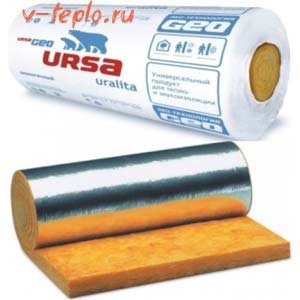
The most popular cotton wool in the domestic market is Rockwool, Izover, Ursa, Parok. The average price for a material with an area of 0.25 cubic meters is 1300 rubles.
Polystyrene foam insulation

The material is a durable thermoplastic, which is produced by fusing polystyrene granules. Produced exclusively in slab format. Foam polystyrene can be used in places with high humidity and significant mechanical stress - durable and strong, foil polystyrene does not rot, is not affected by fungi or mold. Retains its properties in the temperature range from -180 to +180 degrees. For this reason, the material is often used to insulate a warm water floor, in addition, markings can be applied to it by the manufacturer, which facilitates the process of laying heating pipes. Thermal conductivity is up to 0.035 W/m2, density is up to 45 kg/m3.
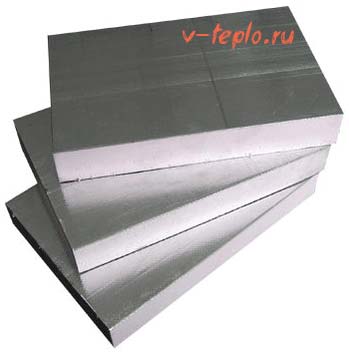
The price, on average, is 90 rubles per plate.
The use of foil thermal insulation materials
The use of insulation with foil always depends on two indicators: the properties of the place in which they will be used, and the properties of a particular insulation. In general, foil materials insulate the floor, increase heat transfer from batteries, insulate pipelines and air ducts for various purposes. The warming of entrance doors, hallways, balconies and verandas also gives a significant effect.
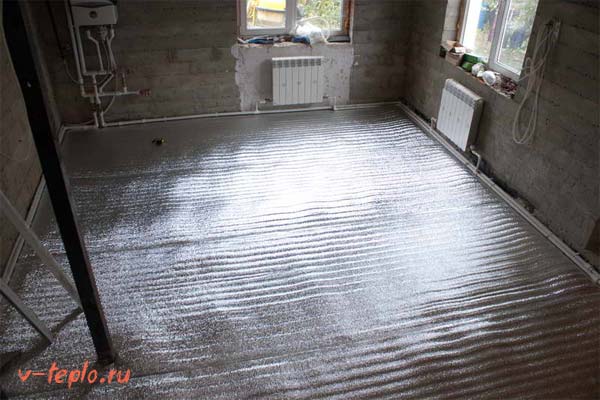
Mounting Features
Starting the installation of foil insulation, you need to prepare some tools that will come in handy in your work:
- small nails, the head of which can be quite large (preferably);
- construction stapler;
- hammer and nail puller;
- foil construction tape;
- foil insulation.
The biggest mistake that builders often make is laying heat-insulating material with foil with the reflective side facing out. Since the foil is a reflector, it is designed to return thermal radiation to the interior of the room, reflecting it. And putting this insulation on the other side, it will not be possible to achieve the expected effect of insulation.
Mounting the reflector under the battery
During installation, it is necessary to leave a margin of space between the finish and the foil insulation of about 2 cm, so that the room is even warmer. The air will also serve as a kind of additional insulator, and the whole structure will work on the principle of a thermos.
When laying the material, it is desirable to enclose it in a wooden crate.
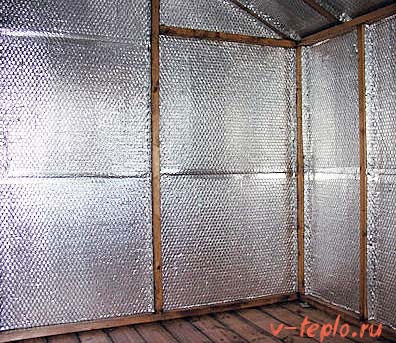
Sheets, roll lengths or insulator boards must never be overlapped! They need to be laid in the same plane end-to-end, fixing with a construction stapler or nails.
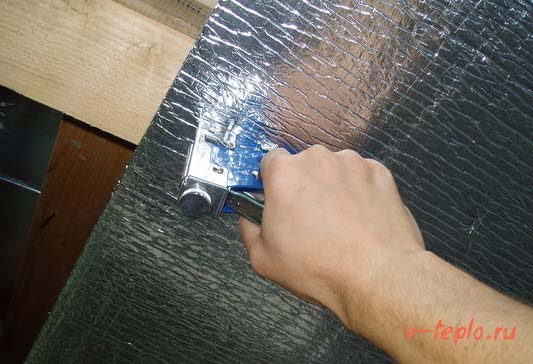
A foil insulator provided with an adhesive coating may not be additionally fixed by mechanical means, but it is better not to forget about nails to ensure the durability of such insulation. If the material does not have an adhesive coating, acrylic or rubber glue is suitable for its fastening, which should only be applied pointwise!
When all sheets of material are laid in their places and fixed, the joints between them must be carefully glued with special foil tape. Installation completed!

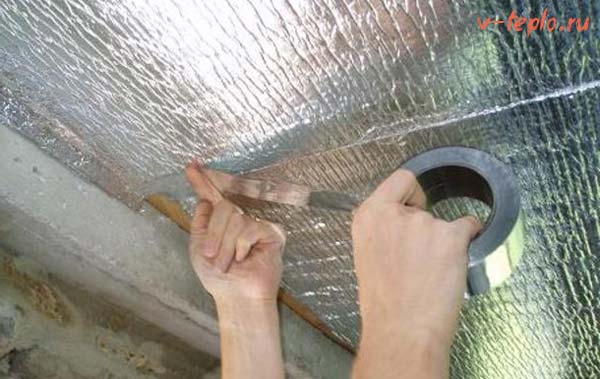
If the foil material will be mounted on a vertical plane (for example, a wall) on which there is wallpaper, mold or other unnecessary phenomena, this surface must be cleaned before gluing the thermal insulation, otherwise the fixation will be mediocre, and the material may fall off over time. In addition, it is desirable to treat the surface with antiseptics.
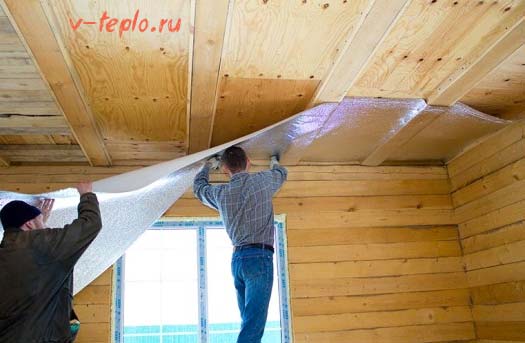
Easy to use, this thermal insulation with foil will save money and keep your home warm and cozy!
 budivel.ru About the insulation and heating of the house.
budivel.ru About the insulation and heating of the house.

